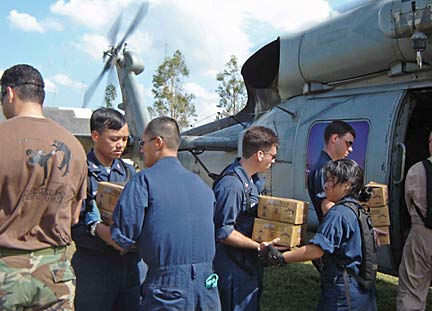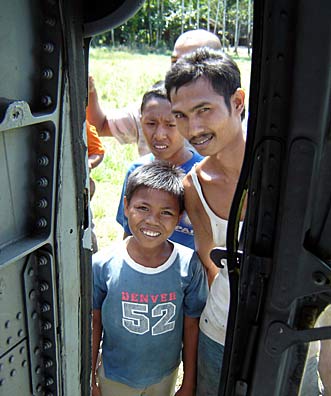
Petty Officer 2nd Class Quyen Ngo, second from left, and Petty Officer 2nd Class Micaela Jorgenson, fifth from left, helped load relief supplies onto a helicopter at the airport in Banda Aceh, Indonesia, last weekend. Ngo is a Kaimuki High School graduate, and Jorgenson grew up in Pearl City and on Maui.

Navy helicopters fly seven days
a week providing aid to refugees
in remote areas of Sumatra
BANDA ACEH, Indonesia » Seven days a week, 10 to 12 hours a day, the U.S. Navy helicopters keep flying, providing food, water, tents and medicine to tsunami and earthquake refugees in remote areas of Sumatra.
|
On assignment
Star-Bulletin reporter Craig Gima is traveling through Southeast Asia to report on tsunami relief efforts.
|
"It's one continuous flight," Hokanson said. The crew never stops flying -- refueling at sea and dropping off five to six loads a day.
The flight goes over the tropical forests and mountains of Sumatra and then to the sea, where for miles along the coast the thick green forests, rice paddies and villages have turned empty and brown.
Western Sumatra has some of Indonesia's best beaches, and before the tsunami the coast must have looked a lot like Hawaii, with coconut trees, white sand and surf breaking on the reefs and shore.
As the helicopter approaches the village, a crowd gathers at the edge of a field. Young men run up, and Hokanson signals them to go around the helicopter to the door on the other side, which they do with a practiced rhythm. When the doors open, two men start grabbing bags of rice and passing them to other men behind them. They jump in the helicopter and continue grabbing supplies and passing them in a chain away from the MH-60. The unloading takes about 10 minutes.
When it's over, the two men shake hands with the crew, and the helicopter lifts off as villagers and smiling children wave goodbye.
"People have become calmer. The mission is a little more organized," Hokanson said.

People in Lhok Guci, Indonesia, happily greet the U.S. helicopter bringing supplies. Coastal residents who lost their homes have taken shelter in the village southwest of Banda Aceh.
In the last five days, the helicopter from the USS San Jose, which is part of the USS Abraham Lincoln battle group, has dropped off about 15,000 pounds of supplies here.
The flight back is directly over the coast. Concrete slabs are the only thing left of homes. Trees are uprooted; bridges, washed out. A boat lies on its side in what was a protected harbor.
The extent of the damage depends on terrain. The water rushed perhaps a mile or more inland in the flatlands, only a couple hundred yards where the land rises.
In another cove two landing craft have come ashore, a sign that the relief effort is becoming more efficient.
On a soccer field next to the military section of the airport at Banda Aceh, volunteers from the USS Shiloh have come ashore to unload supplies from trucks and carry them into the waiting helicopters.
There is no shortage of volunteers, said Petty Officer 2nd Class Micaela Jorgenson, who grew up in Pearl City and Maui. "The whole ship wants to go."
"I hope somebody would help me out if I was in the same situation," said Petty Officer 2nd Class Cedric Blair, who is stationed in Kunia and on temporary duty to the USS Shiloh.
For Petty Officer 2nd Class Queyen Ngo, a Kaimuki High School graduate, the mission is a chance to give back.
He said he joined the Navy because a Navy ship rescued him and his family on a boat from Vietnam. Ngo said he had brought candy ashore to give to any children he sees.
"The Navy saved my life," Ngo said. "I hope one day we'll get a chance to go out and pick people up in the ocean. This is the first chance I've had to help someone."
ewcupdates.eastwestcenter.org/tsunamirelief/
American Red Cross Hawaii
www.hawaiiredcross.org/
Red Cross survivor locator
www.familylinks.icrc.org
Pacific Tsunami Warning Center
www.prh.noaa.gov/ptwc/
U.S. Pacific Command
www.pacom.mil/
[News] [Business] [Features] [Sports] [Editorial] [Do It Electric!]
[Classified Ads] [Search] [Subscribe] [Info] [Letter to Editor]
[Feedback]
